Eliza Knight's Blog, page 69
August 17, 2011
Guest Author, Beth Trissel on INTO THE LION'S HEART
Welcome back to History Undressed Beth! I have always enjoyed reading your books and I look forward to reading your new release, INTO THE LION'S HEART. Thanks for visiting with us today!
Presenting INTO THE LION'S HEART by Beth Trissel
 I'm delighted to celebrate the release of my first English historical romance,
Into the Lion's Heart
, with the gracious Eliza Knight at her lovely blog. I believe this is my third visit to
History Undressed
, but it won't be the last.
Into the Lion's Heart
has the honor of launching the new series The Wild Rose Press is debuting called
Love Letters
. Authors were invited to participate, so I'm doubly honored. The premise behind this theme is that a letter must be the cause of bringing the hero and heroine together. At 96 pages, Into the Lion's Heart is an easy but satisfying read. However, I did as much research for this story as I would a full novel.
I'm delighted to celebrate the release of my first English historical romance,
Into the Lion's Heart
, with the gracious Eliza Knight at her lovely blog. I believe this is my third visit to
History Undressed
, but it won't be the last.
Into the Lion's Heart
has the honor of launching the new series The Wild Rose Press is debuting called
Love Letters
. Authors were invited to participate, so I'm doubly honored. The premise behind this theme is that a letter must be the cause of bringing the hero and heroine together. At 96 pages, Into the Lion's Heart is an easy but satisfying read. However, I did as much research for this story as I would a full novel.
 The connection I feel to the past and those who've gone before me is the ongoing inspiration behind my historical romances, including the time travels in my 'Somewhere' series. I've done a great deal of research into family genealogy and come from well-documented English/Scots-Irish folk with a smidgen of French in the meld, a Norman knight who sailed with William the Conqueror. One family line goes directly back to Geoffrey Chaucer. And there's a puritan line with involvement in the Salem Witch Trials—my apologies to Susannah Martin's descendants--but that's another story. With
Into the Lion's Heart
, I more deeply explored my British ancestry.
The connection I feel to the past and those who've gone before me is the ongoing inspiration behind my historical romances, including the time travels in my 'Somewhere' series. I've done a great deal of research into family genealogy and come from well-documented English/Scots-Irish folk with a smidgen of French in the meld, a Norman knight who sailed with William the Conqueror. One family line goes directly back to Geoffrey Chaucer. And there's a puritan line with involvement in the Salem Witch Trials—my apologies to Susannah Martin's descendants--but that's another story. With
Into the Lion's Heart
, I more deeply explored my British ancestry.

Captain Dalton Evans
Set in 1789 England, the story opens with the hero, Captain Dalton Evans (fought in the American Revolution) journeying to Dover to meet the ship carrying a distant cousin, Mademoiselle Sophia Devereux, who's fleeing the French Revolution. *Pause here to note all the research the revolution took, not to mention Georgian England in general, Cornwall in particular, rum smuggling, stage coach travel and sailing in the late 18th century....you get the idea. But I digress. Back to Dalton who's irked with his mission, not only because he finds it tedious, but he resents the French, partly as a result of their aid to the Americans during the war and some of the Frenchmen he fought during that lost cause. Plus he thinks French aristocrats are arrogant. However, the young woman he rescues from the sinking ship is nothing like he expects and rocks his world.
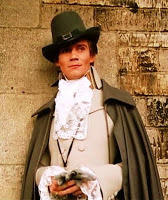
The Scarlet Pimpernel
During all the copious research, I discovered this is a fascinating time period on both sides of the channel. I'm already hooked on The Scarlet Pimpernel , having read all the books in that series several times and watched every film version (ask about my favorites) and am drawn to other novels and productions set in this era, such as the rich epic series, Poldark--read the books and own the Masterpiece Theater production.
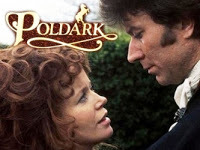
Poldark
As to the language 'thing,' my youngest daughter, Elise, who recently graduated summa cum laude with a double major in art and French, was a huge help with the sprinkling of French words and phrases. And she can debate with anyone who begs to differ with her translation, why she chose a particular verb or whatever. My French is weak, so I'm going with her and will just say it's a beautiful language. I hope you enjoy the story.
Blurb: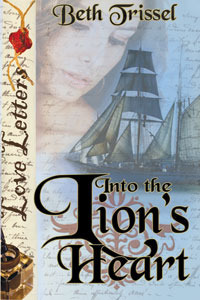 As the French Revolution rages, the English nobility offer sanctuary to many a refugee. Captain Dalton Evans arrives in Dover to meet a distant cousin, expecting to see a spoiled aristocrat. Instead, he's conquered by the simplicity of his new charge. And his best friend Thomas Archer isn't immune to her artless charm, either.
As the French Revolution rages, the English nobility offer sanctuary to many a refugee. Captain Dalton Evans arrives in Dover to meet a distant cousin, expecting to see a spoiled aristocrat. Instead, he's conquered by the simplicity of his new charge. And his best friend Thomas Archer isn't immune to her artless charm, either.
Cecile Beaumont didn't choose to travel across the Channel. And she certainly didn't expect that impersonating her own mistress would introduce her to a most mesmerizing man. Now she must play out the masquerade, or risk life, freedom – and her heart.~Excerpt:Choking on the brine, she thrashed to right herself. Dalton spat saltwater from his mouth and fought to regain his seat while pulling her up with him. Not his most dignified effort. She was the devil to get hold of—kept slipping away. He grabbed her again, only to be knocked back down and rolled with her in the swill on the bottom of the boat.Damn and blast! Tom and another man hoisted them upright in the prow.
"Thanks," Dalton grunted, biting his tongue in the presence of a lady. "All right?" he shouted at her, and shifted her securely onto the seat beside him.
"Oui!" she sputtered when she'd recovered her breath.
She shook all over—must be chilled to the bone. They'd be fortunate if she didn't catch her death, probably bruised too from tossing about in the skiff. The sooner she was safely housed indoors by a toasty hearth, the better.
Keeping an arm around the sodden woman, he peered into a striking pair of charcoal-gray eyes set above a pert nose and framed by fine dark brows.
She parted trembling, bluish lips. "Merci Monsieur—Que Dieu vous bénisse—Les saints nous bénis en préservent," she stammered, thanking, blessing him, and calling on the saints.Dalton was tempted to call on them himself, but her outpouring took him by surprise.
Not content with acknowledging his aid, she turned to Tom, crouched on her other side, and blurted similar gratitude—nearly incoherent in the tumult raging around them. Tom gave a nod through gritted teeth then bent his head over the boat and heaved the contents of his volatile stomach.
She tilted her head at Dalton, eyes crinkled in sympathy. "Mal de mer," she said, using the French for seasick.~
Into the Lion's Heart is available at The Wild Rose Press and other online booksellers.
For more on my work please visit my website: www.bethtrissel.com
My blog is the happening place: http://bethtrissel.wordpress.com/
Leave a comment today and your email address for a chance to win an ebook copy of INTO THE LION'S HEART!
Presenting INTO THE LION'S HEART by Beth Trissel
 I'm delighted to celebrate the release of my first English historical romance,
Into the Lion's Heart
, with the gracious Eliza Knight at her lovely blog. I believe this is my third visit to
History Undressed
, but it won't be the last.
Into the Lion's Heart
has the honor of launching the new series The Wild Rose Press is debuting called
Love Letters
. Authors were invited to participate, so I'm doubly honored. The premise behind this theme is that a letter must be the cause of bringing the hero and heroine together. At 96 pages, Into the Lion's Heart is an easy but satisfying read. However, I did as much research for this story as I would a full novel.
I'm delighted to celebrate the release of my first English historical romance,
Into the Lion's Heart
, with the gracious Eliza Knight at her lovely blog. I believe this is my third visit to
History Undressed
, but it won't be the last.
Into the Lion's Heart
has the honor of launching the new series The Wild Rose Press is debuting called
Love Letters
. Authors were invited to participate, so I'm doubly honored. The premise behind this theme is that a letter must be the cause of bringing the hero and heroine together. At 96 pages, Into the Lion's Heart is an easy but satisfying read. However, I did as much research for this story as I would a full novel.  The connection I feel to the past and those who've gone before me is the ongoing inspiration behind my historical romances, including the time travels in my 'Somewhere' series. I've done a great deal of research into family genealogy and come from well-documented English/Scots-Irish folk with a smidgen of French in the meld, a Norman knight who sailed with William the Conqueror. One family line goes directly back to Geoffrey Chaucer. And there's a puritan line with involvement in the Salem Witch Trials—my apologies to Susannah Martin's descendants--but that's another story. With
Into the Lion's Heart
, I more deeply explored my British ancestry.
The connection I feel to the past and those who've gone before me is the ongoing inspiration behind my historical romances, including the time travels in my 'Somewhere' series. I've done a great deal of research into family genealogy and come from well-documented English/Scots-Irish folk with a smidgen of French in the meld, a Norman knight who sailed with William the Conqueror. One family line goes directly back to Geoffrey Chaucer. And there's a puritan line with involvement in the Salem Witch Trials—my apologies to Susannah Martin's descendants--but that's another story. With
Into the Lion's Heart
, I more deeply explored my British ancestry.
Captain Dalton Evans
Set in 1789 England, the story opens with the hero, Captain Dalton Evans (fought in the American Revolution) journeying to Dover to meet the ship carrying a distant cousin, Mademoiselle Sophia Devereux, who's fleeing the French Revolution. *Pause here to note all the research the revolution took, not to mention Georgian England in general, Cornwall in particular, rum smuggling, stage coach travel and sailing in the late 18th century....you get the idea. But I digress. Back to Dalton who's irked with his mission, not only because he finds it tedious, but he resents the French, partly as a result of their aid to the Americans during the war and some of the Frenchmen he fought during that lost cause. Plus he thinks French aristocrats are arrogant. However, the young woman he rescues from the sinking ship is nothing like he expects and rocks his world.

The Scarlet Pimpernel
During all the copious research, I discovered this is a fascinating time period on both sides of the channel. I'm already hooked on The Scarlet Pimpernel , having read all the books in that series several times and watched every film version (ask about my favorites) and am drawn to other novels and productions set in this era, such as the rich epic series, Poldark--read the books and own the Masterpiece Theater production.

Poldark
As to the language 'thing,' my youngest daughter, Elise, who recently graduated summa cum laude with a double major in art and French, was a huge help with the sprinkling of French words and phrases. And she can debate with anyone who begs to differ with her translation, why she chose a particular verb or whatever. My French is weak, so I'm going with her and will just say it's a beautiful language. I hope you enjoy the story.
Blurb:
 As the French Revolution rages, the English nobility offer sanctuary to many a refugee. Captain Dalton Evans arrives in Dover to meet a distant cousin, expecting to see a spoiled aristocrat. Instead, he's conquered by the simplicity of his new charge. And his best friend Thomas Archer isn't immune to her artless charm, either.
As the French Revolution rages, the English nobility offer sanctuary to many a refugee. Captain Dalton Evans arrives in Dover to meet a distant cousin, expecting to see a spoiled aristocrat. Instead, he's conquered by the simplicity of his new charge. And his best friend Thomas Archer isn't immune to her artless charm, either.Cecile Beaumont didn't choose to travel across the Channel. And she certainly didn't expect that impersonating her own mistress would introduce her to a most mesmerizing man. Now she must play out the masquerade, or risk life, freedom – and her heart.~Excerpt:Choking on the brine, she thrashed to right herself. Dalton spat saltwater from his mouth and fought to regain his seat while pulling her up with him. Not his most dignified effort. She was the devil to get hold of—kept slipping away. He grabbed her again, only to be knocked back down and rolled with her in the swill on the bottom of the boat.Damn and blast! Tom and another man hoisted them upright in the prow.
"Thanks," Dalton grunted, biting his tongue in the presence of a lady. "All right?" he shouted at her, and shifted her securely onto the seat beside him.
"Oui!" she sputtered when she'd recovered her breath.
She shook all over—must be chilled to the bone. They'd be fortunate if she didn't catch her death, probably bruised too from tossing about in the skiff. The sooner she was safely housed indoors by a toasty hearth, the better.
Keeping an arm around the sodden woman, he peered into a striking pair of charcoal-gray eyes set above a pert nose and framed by fine dark brows.
She parted trembling, bluish lips. "Merci Monsieur—Que Dieu vous bénisse—Les saints nous bénis en préservent," she stammered, thanking, blessing him, and calling on the saints.Dalton was tempted to call on them himself, but her outpouring took him by surprise.
Not content with acknowledging his aid, she turned to Tom, crouched on her other side, and blurted similar gratitude—nearly incoherent in the tumult raging around them. Tom gave a nod through gritted teeth then bent his head over the boat and heaved the contents of his volatile stomach.
She tilted her head at Dalton, eyes crinkled in sympathy. "Mal de mer," she said, using the French for seasick.~
Into the Lion's Heart is available at The Wild Rose Press and other online booksellers.
For more on my work please visit my website: www.bethtrissel.com
My blog is the happening place: http://bethtrissel.wordpress.com/
Leave a comment today and your email address for a chance to win an ebook copy of INTO THE LION'S HEART!
Published on August 17, 2011 05:53
August 2, 2011
Guest Author Tara Kingston on Pirates, Privateers, and Hollywood
Today on History Undressed, I'd like to welcome Tara Kingston back! Pirates have always fascinated me, and Hollywood certainly does a great job of perpetuating that fascination. Thanks for stopping by Tara and giving us a closer look!
Pirates, Privateers, and Hollywood by Tara Kingston
 As I begin this post, I need to make two confessions. First, I'm a movie buff. I admit it. I'm hooked. A good movie is one of my favorite things in life. And second, I love pirate movies. Not just pirates, actually. Pirates, privateers, sea captains…love 'em. Maybe it's no coincidence I married a sailor. Something about the lure of the sea gets me every time.
As I begin this post, I need to make two confessions. First, I'm a movie buff. I admit it. I'm hooked. A good movie is one of my favorite things in life. And second, I love pirate movies. Not just pirates, actually. Pirates, privateers, sea captains…love 'em. Maybe it's no coincidence I married a sailor. Something about the lure of the sea gets me every time.
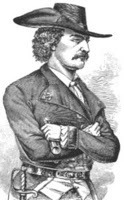 Pirates and privateers throughout history were both feared and celebrated. Jean Lafitte, a hero in the Battle of New Orleans during the War of 1812, was a smuggler and pirate (he claimed to be a privateer rather than a pirate, though the American government charged him with piracy). Transforming from pirate to patriot, he offered Andrew Jackson his assistance against the British in exchange for a pardon for his crew in 1814. The National Park Service maintains the Jean Lafitte National Historic Park and Preserve in southern Louisiana as a lasting tribute to the pirate and patriot's contributions to our country's history. Blackbeard, the infamous English pirate captain of Queen Anne's Revenge, died off the coast of North Carolina in a fierce battle with Royal Navy forces in 1718. Tourist shops in the Outer Banks of North Carolina stock souvenirs with Blackbeard's name and visage and references to the notorious pirate abound throughout Outer Banks villages nearly four hundred years after his death.
Pirates and privateers throughout history were both feared and celebrated. Jean Lafitte, a hero in the Battle of New Orleans during the War of 1812, was a smuggler and pirate (he claimed to be a privateer rather than a pirate, though the American government charged him with piracy). Transforming from pirate to patriot, he offered Andrew Jackson his assistance against the British in exchange for a pardon for his crew in 1814. The National Park Service maintains the Jean Lafitte National Historic Park and Preserve in southern Louisiana as a lasting tribute to the pirate and patriot's contributions to our country's history. Blackbeard, the infamous English pirate captain of Queen Anne's Revenge, died off the coast of North Carolina in a fierce battle with Royal Navy forces in 1718. Tourist shops in the Outer Banks of North Carolina stock souvenirs with Blackbeard's name and visage and references to the notorious pirate abound throughout Outer Banks villages nearly four hundred years after his death.
 Given the ongoing fascination with pirates and privateers, it's little wonder Hollywood has used the swashbucklers as subjects for dozens of movies. Of course, the Hollywood pirate is quite a bit more handsome and appealing than I imagine the actual buccaneers really were. I suspect many of them looked a good deal more like Captain Barbossa than Captain Jack Sparrow of Pirates of the Caribbean fame.
Given the ongoing fascination with pirates and privateers, it's little wonder Hollywood has used the swashbucklers as subjects for dozens of movies. Of course, the Hollywood pirate is quite a bit more handsome and appealing than I imagine the actual buccaneers really were. I suspect many of them looked a good deal more like Captain Barbossa than Captain Jack Sparrow of Pirates of the Caribbean fame.
Speaking of Captain Jack, he's my all-time favorite Hollywood swashbuckler (big surprise, huh?). Even though he wears more eye makeup than I do, I can't resist him. Of course, Johnny Depp has a lot to do with that, but the pirate persona in general is so appealing. Who wouldn't want to be swept off for a few days on a desert island with a man like that? Will Turner and Elizabeth Swan became pirates in their own right, adding to the Hollywood caveat that good pirates are gorgeous and bad pirates are…well, you can figure that one out…
 The Princess Bride is another favorite…who can forget The Dread Pirate Roberts? If you're a classic movie buff, Errol Flynn's Captain Blood was memorable…Flynn might have been before our time, but on film, he's still as handsome as ever. Cutthroat Island was much maligned, but Geena Davis' turn as a daring female pirate was a refreshing change, in my opinion, and Matthew Modine was certainly worth a look or two (or three or four…).
The Princess Bride is another favorite…who can forget The Dread Pirate Roberts? If you're a classic movie buff, Errol Flynn's Captain Blood was memorable…Flynn might have been before our time, but on film, he's still as handsome as ever. Cutthroat Island was much maligned, but Geena Davis' turn as a daring female pirate was a refreshing change, in my opinion, and Matthew Modine was certainly worth a look or two (or three or four…).
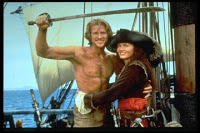 My love of pirate movies partly inspired my Ellora's Cave debut, Claimed by the Captain, is the story of an American privateer who's seized his enemy's daughter as payback for a devastating act that destroyed his family. Here's a little about the story:
My love of pirate movies partly inspired my Ellora's Cave debut, Claimed by the Captain, is the story of an American privateer who's seized his enemy's daughter as payback for a devastating act that destroyed his family. Here's a little about the story:
Jason Kane lost everything to one man's treachery. Thirsting for vengeance, the ruthless privateer abducts Catherine Farrell, daughter of the swindler who destroyed his family. Intending to extract the debt owed him from his tempting prisoner, he plans a cold-blooded conquest. Aroused by his captive's sensual beauty, he claims her with seductive persuasion. As he plunges her into a world of pleasure, her passionate surrender sparks a deep longing in his heart and soul.
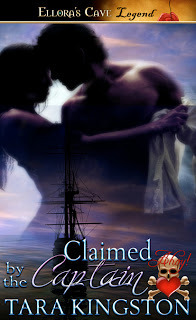 Catherine Farrell lived the sheltered life of a prosperous merchant's daughter until Captain Jason Kane made her a pawn in his quest for retribution. Claimed by the captain, she finds herself at the mercy of a man who will settle for nothing less than complete domination. His tender mastery awakens Catherine's passions and stirs her heart. If only she can convince him that love is far more satisfying than sweet revenge.
Catherine Farrell lived the sheltered life of a prosperous merchant's daughter until Captain Jason Kane made her a pawn in his quest for retribution. Claimed by the captain, she finds herself at the mercy of a man who will settle for nothing less than complete domination. His tender mastery awakens Catherine's passions and stirs her heart. If only she can convince him that love is far more satisfying than sweet revenge.
For an excerpt and to learn more about Claimed by the Captain, please check out the Ellora's Cave site.
So, what's your favorite pirate movie? Leave a comment by Friday, August 5 for a chance to win a free e-book of Claimed by the Captain.
After you've done that, please stop by my website, http://www.tarakingston.com/. Leave a comment there (again, by August 5) for another chance to win. I'm on Twitter and Facebook. Hope to see you there!

Pirates, Privateers, and Hollywood by Tara Kingston
 As I begin this post, I need to make two confessions. First, I'm a movie buff. I admit it. I'm hooked. A good movie is one of my favorite things in life. And second, I love pirate movies. Not just pirates, actually. Pirates, privateers, sea captains…love 'em. Maybe it's no coincidence I married a sailor. Something about the lure of the sea gets me every time.
As I begin this post, I need to make two confessions. First, I'm a movie buff. I admit it. I'm hooked. A good movie is one of my favorite things in life. And second, I love pirate movies. Not just pirates, actually. Pirates, privateers, sea captains…love 'em. Maybe it's no coincidence I married a sailor. Something about the lure of the sea gets me every time. Pirates and privateers throughout history were both feared and celebrated. Jean Lafitte, a hero in the Battle of New Orleans during the War of 1812, was a smuggler and pirate (he claimed to be a privateer rather than a pirate, though the American government charged him with piracy). Transforming from pirate to patriot, he offered Andrew Jackson his assistance against the British in exchange for a pardon for his crew in 1814. The National Park Service maintains the Jean Lafitte National Historic Park and Preserve in southern Louisiana as a lasting tribute to the pirate and patriot's contributions to our country's history. Blackbeard, the infamous English pirate captain of Queen Anne's Revenge, died off the coast of North Carolina in a fierce battle with Royal Navy forces in 1718. Tourist shops in the Outer Banks of North Carolina stock souvenirs with Blackbeard's name and visage and references to the notorious pirate abound throughout Outer Banks villages nearly four hundred years after his death.
Pirates and privateers throughout history were both feared and celebrated. Jean Lafitte, a hero in the Battle of New Orleans during the War of 1812, was a smuggler and pirate (he claimed to be a privateer rather than a pirate, though the American government charged him with piracy). Transforming from pirate to patriot, he offered Andrew Jackson his assistance against the British in exchange for a pardon for his crew in 1814. The National Park Service maintains the Jean Lafitte National Historic Park and Preserve in southern Louisiana as a lasting tribute to the pirate and patriot's contributions to our country's history. Blackbeard, the infamous English pirate captain of Queen Anne's Revenge, died off the coast of North Carolina in a fierce battle with Royal Navy forces in 1718. Tourist shops in the Outer Banks of North Carolina stock souvenirs with Blackbeard's name and visage and references to the notorious pirate abound throughout Outer Banks villages nearly four hundred years after his death. Given the ongoing fascination with pirates and privateers, it's little wonder Hollywood has used the swashbucklers as subjects for dozens of movies. Of course, the Hollywood pirate is quite a bit more handsome and appealing than I imagine the actual buccaneers really were. I suspect many of them looked a good deal more like Captain Barbossa than Captain Jack Sparrow of Pirates of the Caribbean fame.
Given the ongoing fascination with pirates and privateers, it's little wonder Hollywood has used the swashbucklers as subjects for dozens of movies. Of course, the Hollywood pirate is quite a bit more handsome and appealing than I imagine the actual buccaneers really were. I suspect many of them looked a good deal more like Captain Barbossa than Captain Jack Sparrow of Pirates of the Caribbean fame. Speaking of Captain Jack, he's my all-time favorite Hollywood swashbuckler (big surprise, huh?). Even though he wears more eye makeup than I do, I can't resist him. Of course, Johnny Depp has a lot to do with that, but the pirate persona in general is so appealing. Who wouldn't want to be swept off for a few days on a desert island with a man like that? Will Turner and Elizabeth Swan became pirates in their own right, adding to the Hollywood caveat that good pirates are gorgeous and bad pirates are…well, you can figure that one out…
 The Princess Bride is another favorite…who can forget The Dread Pirate Roberts? If you're a classic movie buff, Errol Flynn's Captain Blood was memorable…Flynn might have been before our time, but on film, he's still as handsome as ever. Cutthroat Island was much maligned, but Geena Davis' turn as a daring female pirate was a refreshing change, in my opinion, and Matthew Modine was certainly worth a look or two (or three or four…).
The Princess Bride is another favorite…who can forget The Dread Pirate Roberts? If you're a classic movie buff, Errol Flynn's Captain Blood was memorable…Flynn might have been before our time, but on film, he's still as handsome as ever. Cutthroat Island was much maligned, but Geena Davis' turn as a daring female pirate was a refreshing change, in my opinion, and Matthew Modine was certainly worth a look or two (or three or four…). My love of pirate movies partly inspired my Ellora's Cave debut, Claimed by the Captain, is the story of an American privateer who's seized his enemy's daughter as payback for a devastating act that destroyed his family. Here's a little about the story:
My love of pirate movies partly inspired my Ellora's Cave debut, Claimed by the Captain, is the story of an American privateer who's seized his enemy's daughter as payback for a devastating act that destroyed his family. Here's a little about the story:Jason Kane lost everything to one man's treachery. Thirsting for vengeance, the ruthless privateer abducts Catherine Farrell, daughter of the swindler who destroyed his family. Intending to extract the debt owed him from his tempting prisoner, he plans a cold-blooded conquest. Aroused by his captive's sensual beauty, he claims her with seductive persuasion. As he plunges her into a world of pleasure, her passionate surrender sparks a deep longing in his heart and soul.
 Catherine Farrell lived the sheltered life of a prosperous merchant's daughter until Captain Jason Kane made her a pawn in his quest for retribution. Claimed by the captain, she finds herself at the mercy of a man who will settle for nothing less than complete domination. His tender mastery awakens Catherine's passions and stirs her heart. If only she can convince him that love is far more satisfying than sweet revenge.
Catherine Farrell lived the sheltered life of a prosperous merchant's daughter until Captain Jason Kane made her a pawn in his quest for retribution. Claimed by the captain, she finds herself at the mercy of a man who will settle for nothing less than complete domination. His tender mastery awakens Catherine's passions and stirs her heart. If only she can convince him that love is far more satisfying than sweet revenge.For an excerpt and to learn more about Claimed by the Captain, please check out the Ellora's Cave site.
So, what's your favorite pirate movie? Leave a comment by Friday, August 5 for a chance to win a free e-book of Claimed by the Captain.
After you've done that, please stop by my website, http://www.tarakingston.com/. Leave a comment there (again, by August 5) for another chance to win. I'm on Twitter and Facebook. Hope to see you there!
Published on August 02, 2011 05:24
July 29, 2011
Introducing Debut Tudor-era Historical Fiction Author, Michelle Diener (Giveaway!)
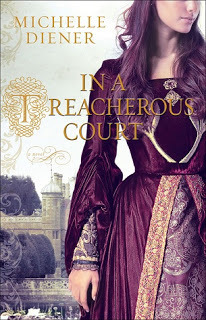 Today I'd like to welcome a special guest, Michelle Diener to History Undressed. Michelle and I met online a year or so ago through a mutual author friend, Kris Kennedy, and I was excited to meet her this summer in NYC at the Romance Writers of America national conference. Michelle is as delightful in person as she is online, and on top of that, she is an amazing writer. Without further ado, I'll let Michelle take the floor and tell you a bit about her upcoming novel IN A TREACHEROUS COURT and the vibrant historical figures she's written about...
Today I'd like to welcome a special guest, Michelle Diener to History Undressed. Michelle and I met online a year or so ago through a mutual author friend, Kris Kennedy, and I was excited to meet her this summer in NYC at the Romance Writers of America national conference. Michelle is as delightful in person as she is online, and on top of that, she is an amazing writer. Without further ado, I'll let Michelle take the floor and tell you a bit about her upcoming novel IN A TREACHEROUS COURT and the vibrant historical figures she's written about...Thank you to Eliza for inviting me to blog! I thought I'd talk about the heroine of my Tudor-set historical as I count down to the release of my debut novel, IN A TREACHEROUS COURT, which is set in the court of Henry VIII.
The main characters in IN A TREACHEROUS COURT are based on real people. My heroine, Susanna Horenbout, was trained in her father's studio in Ghent (in modern day Belgium), and art historians are sure she was sent over to Henry's court ahead of her father and brother. The hero is John Parker, one of Henry VIII's 'new men', courtiers who were not noblemen, but in the meritocracy Henry began to establish, loyalty, and usefulness, could definitely overcome a lack of blue blood. They are both outsiders, but talented enough, and intelligent enough, to find a place for themselves in the world they find themselves in.
And what a world it is! Aside from the fact that historians know Susanna was sent to London before the rest of her family, and that she worked for her father in his studio, and that her work was highly praised by one of the most eminent artists of the day, Albrech Dürer, there is no record of what she did for Henry VIII as an artist that remains. This gives me a lot of leeway in my work, which is a great plus, but it saddens me that there are no records or works that remain that can be attributed to her. There is a brass plaque in All Saints Church in Fulham, London, which commemorates her mother, and art historians think it is likely the piece is by her, but that is the only thing we have of hers left. We know she was given a gold cup at Christmas by Henry on two occasions, something he gave to those who had rendered him great service during that year, but we don't know what that service was. I have made up something full of intrigue and danger, of course :) .
However, if she did work for Henry as a painter, which seems the obvious conclusion to draw, then she would have been one of only three women who did work personally for Henry at the time - the other two were Anne Harris, who did his laundry, and Mrs Cornwallis, who made the King's puddings. There were four other women employees, but they worked in the laundry as well, and washed the Queen's clothes. Everything else was done by men. It puts into perspective the kind of attitudes and prejudices Susanna would have encountered. And on top of that, she was a foreigner.
All of this, of course, leads me to another mystery, and that is how Susanna and Parker came to meet and marry. The way art historians were able to work out that Susanna preceded her family was a record of her marriage to Parker, which pre-dated the time when her brother entered Henry's employ. How did she come to marry a courtier who, as the Keeper of the Palace of Westminster, held the King's personal purse? Parker was also Yeoman of the Crossbows, and was later promoted to Yeoman of the King's Robes. Henry would usually marry off the daughters of his courtiers to other courtiers, manipulating and balancing the power of his court through these connections. So for Parker to marry an artist from Ghent, with no connection to court? Very intriguing!
As you can tell, I had a great deal of fun writing the books, and loved how much real history I could use to do so. To celebrate the upcoming release, I'll be giving away a copy of IN A TREACHEROUS COURT to one lucky commenter, and I'd love to know, what is your favorite historical period?
Michelle Diener is the author Tudor-set historical fiction. Her debut, IN A TREACHEROUS COURT releases August 2011 and the second book in the series will release in early 2012. Ms. Diener was born in London, raised in South Africa and now resides in Australia. Visit her website for more information on her books (pre-order available!) her writing and her! http://www.michellediener.com/
Published on July 29, 2011 04:15
July 28, 2011
Guest Author Vonda Sinclair on Scottish Crofts and Cottages
Today on History Undressed, I'd like to introduce you to a new special guest author, Vonda Sinclair, whom I've known for several years. She travels yearly to Scotland, and writes amazing Scottish historical romances. Today she is bringing us some of the knowledge she's come across over the years on Scottish cottages and crofts. I'm very excited about this post! I've always been fascinated with cottages and she has shared some fantastic pictures she took while visiting Scotland.
Scottish Crofts and Cottages with Vonda Sinclair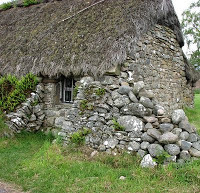 Cottage at Culloden BattlefieldWhen I began writing My Fierce Highlander, a historical romance which takes place in the Highlands of Scotland in 1618, I realized I needed to know more details about the cottage the English heroine had lived in for more than three years.
Cottage at Culloden BattlefieldWhen I began writing My Fierce Highlander, a historical romance which takes place in the Highlands of Scotland in 1618, I realized I needed to know more details about the cottage the English heroine had lived in for more than three years.
 Cottage
Cottage
I was fortunate to get to visit the Museum of Island Life on Isle of Skye and also the thatched cottage on Culloden Battlefield which served as a primitive hospital during the battle.
These homes as seen today are primarily reconstructions of nineteenth century homes, or perhaps they were altered over the years. They have windows and higher walls, as well as fireplaces.
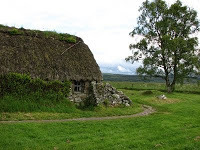 Cottage at Culloden Battlefield
Cottage at Culloden Battlefield
Originally, most Highland homes had very low walls, no fireplace, no windows, and only one door. The builders would've used whatever stones were locally available that they could transport. If they had access to fewer suitable stones, then the walls would've been lower. They "cemented" these together with mud and sand, but sometimes they were dry-stacked. The walls were about three feet thick, or sometimes more, especially on the islands. If the rock walls were low, sometimes sod was used to create the rest of the wall height. Neighbors and communities pitched in to help build houses because it would've been a huge job to transport all those stones.
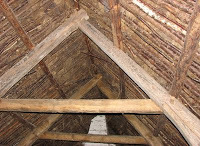 The roof was a more important and valuable aspect of the homes because they required timber framing, and wood was scarce in the Highlands because of so few trees. On the islands or near the coast, people would pull in the wood from ship wrecks that washed up on shore and use that for framing the roof. When they moved, they would often take the timber framing of the roof with them because it would've been very expensive (or perhaps impossible) to replace this without resources. It was reported by Buchanan in the late eighteenth century that in the Hebrides the resident owned the roof timbers, which he provided himself, but the tacksman or laird owned the stone walls.
The roof was a more important and valuable aspect of the homes because they required timber framing, and wood was scarce in the Highlands because of so few trees. On the islands or near the coast, people would pull in the wood from ship wrecks that washed up on shore and use that for framing the roof. When they moved, they would often take the timber framing of the roof with them because it would've been very expensive (or perhaps impossible) to replace this without resources. It was reported by Buchanan in the late eighteenth century that in the Hebrides the resident owned the roof timbers, which he provided himself, but the tacksman or laird owned the stone walls.
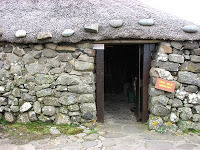 SmithyOn the islands, hip roofs were common, rather than roofs with gable ends, which helped the cottage withstand the strong winds common on the islands or coast. On the Mainland, gable ends were seen more often.
SmithyOn the islands, hip roofs were common, rather than roofs with gable ends, which helped the cottage withstand the strong winds common on the islands or coast. On the Mainland, gable ends were seen more often.
To make a roof, the builders created an A frame with large timbers, with smaller pieces of wood between to secure them together. These frames were raised into place and covered with branches and sod, and then finally thatch, which was usually locally available reeds, rushes, heath, or grasses.
 Thatch roofThe floors would've been dirt with a fire pit in the center of the floor. An offset opening in the roof allowed some of the smoke to escape. Still, it would've been a very smoky home. Dried peat was burned and the fire was kept going all the time. The people who lived there would've sat around the fire pit on low stools. This was the center of the home and all the cooking was done here.
Thatch roofThe floors would've been dirt with a fire pit in the center of the floor. An offset opening in the roof allowed some of the smoke to escape. Still, it would've been a very smoky home. Dried peat was burned and the fire was kept going all the time. The people who lived there would've sat around the fire pit on low stools. This was the center of the home and all the cooking was done here.
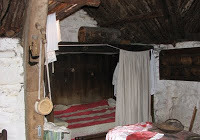 Inside a cottage at Culloden Battlefield
Inside a cottage at Culloden Battlefield
The cottages were generally one room, but partitions of wattle and clay were installed to create one or two separate "rooms." Box beds were used to sleep in and families would've slept closely together for warmth, especially in winter. The box beds had either a curtain or doors they could close to keep in the warmth or perhaps for privacy. The mattresses were stuffed with straw. Blankets were handmade and woven of wool. Other cloth items were made of locally grown flax and the linen woven by hand.
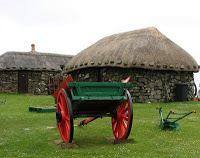 Cart
Cart
A separate room or section of the home was for the livestock, especially cattle, to stay in winter. This section was lower than the rest of the cottage to allow for the drainage of waste. It was so cold, keeping the cattle indoors all winter was the only way they could survive. Often there was not enough food for either the people or the cattle, and in spring the cattle were so weak they had to be carried outside so they could start eating again.
*****
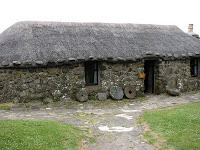 Croft
Croft
Vonda Sinclair's favorite indulgent pastime is exploring Scotland, from Edinburgh to the untamed and windblown north coast. She also enjoys creating hot, Highland heroes and spirited lasses to drive them mad. She is a past Golden Heart finalist and Laurie award winner. She lives with her amazing and supportive husband in the mountains of North Carolina where she is no doubt creating another Scottish story. Please visit her website to learn more. http://www.vondasinclair.com/
My Fierce Highlander By Vonda Sinclair
 Gwyneth Carswell, an English lady banished by her father to the harsh Scottish Highlands, wants nothing more than to take her young son away from the violence of two fighting clans--her own distant kin, the MacIrwins, and their enemies, the MacGraths. She risks everything to rescue the fierce MacGrath warrior from the battlefield where he's left for dead by her clan. She only knows she is inexplicably drawn to him and he wants peace as she does. When her clan learns of her betrayal, they seek
Gwyneth Carswell, an English lady banished by her father to the harsh Scottish Highlands, wants nothing more than to take her young son away from the violence of two fighting clans--her own distant kin, the MacIrwins, and their enemies, the MacGraths. She risks everything to rescue the fierce MacGrath warrior from the battlefield where he's left for dead by her clan. She only knows she is inexplicably drawn to him and he wants peace as she does. When her clan learns of her betrayal, they seek
vengeance. Dare she trust the enemy more than her own family?
Laird Alasdair MacGrath is driven to end two-hundred years of feuding with the MacIrwins. But by taking in and protecting Lady Gwyneth and her son, he provokes more attacks from his mortal enemy. As the danger and conflict surrounding them escalate, Alasdair and Gwyneth discover an explosive passion neither of them expected. With the arrival of a powerful man from her past, a horrible decision confronts her--give up her son or the man she loves.
Excerpt:
My Fierce Highlander ©2011, Vonda Sinclair
Breathing hard, Gwyneth burst through the door, the bitter scent of peat smoke and tangy drying herbs replacing that of fresh air. "Mora, did you hear the battle?"
"Aye, I reckon they were fighting the MacGrath. 'Tis always a blood feud betwixt them." Her friend and fellow healer bent over her knitting, her gray head wrapped in a white kerch. The fire smoldering in the center of the room provided little light.
"One man still lives. He's been knocked out, but his breathing is strong. We must bring him here and see to his injuries."
"Who is he?" Suspicion laced through Mora's thick brogue.
"I know not."
"One of the enemy?"
"Likely."
"Mmph. I won't be helping the MacGraths."
"A dozen men are dead. For what purpose? All this fighting is madness!"
"Easy for you to say, English. Lived here nigh on six years, you have, and still you ken naught of our Highland ways."
She knew enough about their violent way of life and hated it. Gwyneth glanced at her five-year-old son sleeping in the box bed on the other side of the room and lowered her voice. "I would die before I'd let Rory become one of them, giving up his precious life over a senseless dispute." She had to find a way to take him out of the Highlands before Laird Donald MacIrwin forced him into the ranks of his fighting men. "And you're right, I cannot understand so much bloodshed over nothing."
"'Tis not for naught. The MacGraths killed Donald's brother ten years past. Then there was the time the MacGraths claimed a goodly portion of MacIrwin land. We don't take the stealing of land lightly."
How could her friend be so cold? "This man who yet lives is carrying a peace treaty. He wears a seal ring and appears to be the chief. Aside from that, he's human and we're healers. If I can save a life, I will, whether he is friend, foe or beast."
"Aye, you with your gentle lady's heart. You'll get us killed. What if Donald finds out?"
A chill raced through her at that thought. "He rarely comes here." Though the clan chief was her second cousin on her father's side, no fondness existed between them.
"'Tis a bad feeling I have about this. You'll regret it."
"Do you not think the MacGraths will exact a severe revenge against us all if the MacIrwins kill their chief? He wants peace, as we do."
"Well, this is not the way to go about it. I've been around a few years longer than you have, Sassenach."
"I will drag the big brute up here myself, then." She yanked a blanket off the bed, left the cottage and strode down the hill once again toward the glen. The stones slid and rolled beneath her slippers and bit into her feet. If Mora wouldn't help her, she'd do what she could for the man.
Something all-consuming rose up from her soul and railed, refusing to allow him to lie there and die. Though his body looked powerful, he was helpless now. As helpless as a child, helpless as little Rory. All this man's fearsomeness at her mercy, she was awed by the power she held over him, to help him reclaim his strength and his life…or let it drain away. That would be a sin far worse than any she'd ever committed, of which she had many. The peace treaty and something deep within her proclaimed his life was worth saving a hundred times over.
My Fierce Highlander by Vonda Sinclair available now in ebook from Amazon, Smashwords and Barnes and Noble

Scottish Crofts and Cottages with Vonda Sinclair
 Cottage at Culloden BattlefieldWhen I began writing My Fierce Highlander, a historical romance which takes place in the Highlands of Scotland in 1618, I realized I needed to know more details about the cottage the English heroine had lived in for more than three years.
Cottage at Culloden BattlefieldWhen I began writing My Fierce Highlander, a historical romance which takes place in the Highlands of Scotland in 1618, I realized I needed to know more details about the cottage the English heroine had lived in for more than three years.
 Cottage
Cottage I was fortunate to get to visit the Museum of Island Life on Isle of Skye and also the thatched cottage on Culloden Battlefield which served as a primitive hospital during the battle.
These homes as seen today are primarily reconstructions of nineteenth century homes, or perhaps they were altered over the years. They have windows and higher walls, as well as fireplaces.
 Cottage at Culloden Battlefield
Cottage at Culloden Battlefield Originally, most Highland homes had very low walls, no fireplace, no windows, and only one door. The builders would've used whatever stones were locally available that they could transport. If they had access to fewer suitable stones, then the walls would've been lower. They "cemented" these together with mud and sand, but sometimes they were dry-stacked. The walls were about three feet thick, or sometimes more, especially on the islands. If the rock walls were low, sometimes sod was used to create the rest of the wall height. Neighbors and communities pitched in to help build houses because it would've been a huge job to transport all those stones.
 The roof was a more important and valuable aspect of the homes because they required timber framing, and wood was scarce in the Highlands because of so few trees. On the islands or near the coast, people would pull in the wood from ship wrecks that washed up on shore and use that for framing the roof. When they moved, they would often take the timber framing of the roof with them because it would've been very expensive (or perhaps impossible) to replace this without resources. It was reported by Buchanan in the late eighteenth century that in the Hebrides the resident owned the roof timbers, which he provided himself, but the tacksman or laird owned the stone walls.
The roof was a more important and valuable aspect of the homes because they required timber framing, and wood was scarce in the Highlands because of so few trees. On the islands or near the coast, people would pull in the wood from ship wrecks that washed up on shore and use that for framing the roof. When they moved, they would often take the timber framing of the roof with them because it would've been very expensive (or perhaps impossible) to replace this without resources. It was reported by Buchanan in the late eighteenth century that in the Hebrides the resident owned the roof timbers, which he provided himself, but the tacksman or laird owned the stone walls.
 SmithyOn the islands, hip roofs were common, rather than roofs with gable ends, which helped the cottage withstand the strong winds common on the islands or coast. On the Mainland, gable ends were seen more often.
SmithyOn the islands, hip roofs were common, rather than roofs with gable ends, which helped the cottage withstand the strong winds common on the islands or coast. On the Mainland, gable ends were seen more often.
To make a roof, the builders created an A frame with large timbers, with smaller pieces of wood between to secure them together. These frames were raised into place and covered with branches and sod, and then finally thatch, which was usually locally available reeds, rushes, heath, or grasses.
 Thatch roofThe floors would've been dirt with a fire pit in the center of the floor. An offset opening in the roof allowed some of the smoke to escape. Still, it would've been a very smoky home. Dried peat was burned and the fire was kept going all the time. The people who lived there would've sat around the fire pit on low stools. This was the center of the home and all the cooking was done here.
Thatch roofThe floors would've been dirt with a fire pit in the center of the floor. An offset opening in the roof allowed some of the smoke to escape. Still, it would've been a very smoky home. Dried peat was burned and the fire was kept going all the time. The people who lived there would've sat around the fire pit on low stools. This was the center of the home and all the cooking was done here.
 Inside a cottage at Culloden Battlefield
Inside a cottage at Culloden Battlefield The cottages were generally one room, but partitions of wattle and clay were installed to create one or two separate "rooms." Box beds were used to sleep in and families would've slept closely together for warmth, especially in winter. The box beds had either a curtain or doors they could close to keep in the warmth or perhaps for privacy. The mattresses were stuffed with straw. Blankets were handmade and woven of wool. Other cloth items were made of locally grown flax and the linen woven by hand.
 Cart
Cart A separate room or section of the home was for the livestock, especially cattle, to stay in winter. This section was lower than the rest of the cottage to allow for the drainage of waste. It was so cold, keeping the cattle indoors all winter was the only way they could survive. Often there was not enough food for either the people or the cattle, and in spring the cattle were so weak they had to be carried outside so they could start eating again.
*****
 Croft
Croft Vonda Sinclair's favorite indulgent pastime is exploring Scotland, from Edinburgh to the untamed and windblown north coast. She also enjoys creating hot, Highland heroes and spirited lasses to drive them mad. She is a past Golden Heart finalist and Laurie award winner. She lives with her amazing and supportive husband in the mountains of North Carolina where she is no doubt creating another Scottish story. Please visit her website to learn more. http://www.vondasinclair.com/
My Fierce Highlander By Vonda Sinclair
 Gwyneth Carswell, an English lady banished by her father to the harsh Scottish Highlands, wants nothing more than to take her young son away from the violence of two fighting clans--her own distant kin, the MacIrwins, and their enemies, the MacGraths. She risks everything to rescue the fierce MacGrath warrior from the battlefield where he's left for dead by her clan. She only knows she is inexplicably drawn to him and he wants peace as she does. When her clan learns of her betrayal, they seek
Gwyneth Carswell, an English lady banished by her father to the harsh Scottish Highlands, wants nothing more than to take her young son away from the violence of two fighting clans--her own distant kin, the MacIrwins, and their enemies, the MacGraths. She risks everything to rescue the fierce MacGrath warrior from the battlefield where he's left for dead by her clan. She only knows she is inexplicably drawn to him and he wants peace as she does. When her clan learns of her betrayal, they seek vengeance. Dare she trust the enemy more than her own family?
Laird Alasdair MacGrath is driven to end two-hundred years of feuding with the MacIrwins. But by taking in and protecting Lady Gwyneth and her son, he provokes more attacks from his mortal enemy. As the danger and conflict surrounding them escalate, Alasdair and Gwyneth discover an explosive passion neither of them expected. With the arrival of a powerful man from her past, a horrible decision confronts her--give up her son or the man she loves.
Excerpt:
My Fierce Highlander ©2011, Vonda Sinclair
Breathing hard, Gwyneth burst through the door, the bitter scent of peat smoke and tangy drying herbs replacing that of fresh air. "Mora, did you hear the battle?"
"Aye, I reckon they were fighting the MacGrath. 'Tis always a blood feud betwixt them." Her friend and fellow healer bent over her knitting, her gray head wrapped in a white kerch. The fire smoldering in the center of the room provided little light.
"One man still lives. He's been knocked out, but his breathing is strong. We must bring him here and see to his injuries."
"Who is he?" Suspicion laced through Mora's thick brogue.
"I know not."
"One of the enemy?"
"Likely."
"Mmph. I won't be helping the MacGraths."
"A dozen men are dead. For what purpose? All this fighting is madness!"
"Easy for you to say, English. Lived here nigh on six years, you have, and still you ken naught of our Highland ways."
She knew enough about their violent way of life and hated it. Gwyneth glanced at her five-year-old son sleeping in the box bed on the other side of the room and lowered her voice. "I would die before I'd let Rory become one of them, giving up his precious life over a senseless dispute." She had to find a way to take him out of the Highlands before Laird Donald MacIrwin forced him into the ranks of his fighting men. "And you're right, I cannot understand so much bloodshed over nothing."
"'Tis not for naught. The MacGraths killed Donald's brother ten years past. Then there was the time the MacGraths claimed a goodly portion of MacIrwin land. We don't take the stealing of land lightly."
How could her friend be so cold? "This man who yet lives is carrying a peace treaty. He wears a seal ring and appears to be the chief. Aside from that, he's human and we're healers. If I can save a life, I will, whether he is friend, foe or beast."
"Aye, you with your gentle lady's heart. You'll get us killed. What if Donald finds out?"
A chill raced through her at that thought. "He rarely comes here." Though the clan chief was her second cousin on her father's side, no fondness existed between them.
"'Tis a bad feeling I have about this. You'll regret it."
"Do you not think the MacGraths will exact a severe revenge against us all if the MacIrwins kill their chief? He wants peace, as we do."
"Well, this is not the way to go about it. I've been around a few years longer than you have, Sassenach."
"I will drag the big brute up here myself, then." She yanked a blanket off the bed, left the cottage and strode down the hill once again toward the glen. The stones slid and rolled beneath her slippers and bit into her feet. If Mora wouldn't help her, she'd do what she could for the man.
Something all-consuming rose up from her soul and railed, refusing to allow him to lie there and die. Though his body looked powerful, he was helpless now. As helpless as a child, helpless as little Rory. All this man's fearsomeness at her mercy, she was awed by the power she held over him, to help him reclaim his strength and his life…or let it drain away. That would be a sin far worse than any she'd ever committed, of which she had many. The peace treaty and something deep within her proclaimed his life was worth saving a hundred times over.
My Fierce Highlander by Vonda Sinclair available now in ebook from Amazon, Smashwords and Barnes and Noble
Published on July 28, 2011 04:56
July 27, 2011
The Queen is With-Child...er Not?
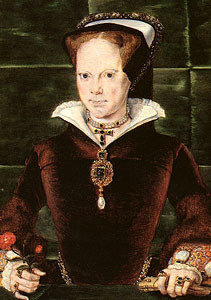 To think one is with-child seems a relatively easy situation to figure out--just take a pregnancy test right? See a physician? Well, yes, today, that is what people generally do... unless you are one of those women on that show about never knowing you're pregnant until the baby happened to pop out... sigh...
To think one is with-child seems a relatively easy situation to figure out--just take a pregnancy test right? See a physician? Well, yes, today, that is what people generally do... unless you are one of those women on that show about never knowing you're pregnant until the baby happened to pop out... sigh...But in Tudor times, there were no pregnancy tests. For a queen, noble, or any other lady, she had to keep track of her menses. If she missed two or three in a row, she was most likely preggers.
For Mary Tudor, aka Mary I of England, aka "Bloody Mary," the daughter of Henry VIII and Catherine of Aragon, defining one's self as pregnant would not be so easy.
Poor Mary suffered terribly with her menses from the time of her youth until the time of her death. Horrible cramps (dysmenorrhea), missed periods, megrims (migraines), mood swings, etc... If a GYN doctor were to take a look at her today, she may have suffered from endometriosis and maybe uterine fibroids. It is documented that stress can make a woman's menses more severe--and Mary was under A LOT of stress.
At long last, after suffering for decades at the hands of others, at aged 37, Mary was proclaimed Queen of England and it appeared that all of her dreams may be coming true. She was even going to get married to a handsome Spanish prince, Philip (whom the English had not taken a fancy too). Young Philip was eleven years her junior and a recent widow. His age did send Mary into a bit of worry, having her say, he was "likely to be disposed to be amorous, and such is not my desire, not at my time of life, and never having harbored thoughts of love."
And why would she be amorous? She'd been threatened with death and pain for nearly her entire life? Beginning when she was about 9-12 years old (exact year is questionable) and her father met the infamous Anne Boleyn.
But now, being betrothed to a handsome young prince, and being Queen of England, life was starting to finally look good to Mary. While she still suffered from her menses, she was also still having them which meant she was fertile and could potentially, with much prayer and sex with her new husband, conceive. Philip and Mary were married on July 25, 1554, and by September her physician's announced that she was with-child.
After finding out she was with-child, Mary went gangbusters on the English people, and set about returning the realm to Catholicism, and heresy laws were returned to parliament. No way did she want her unborn heir to grace the earth on the day of his birth if it were not in a Catholic realm. And so the burnings began with the swell of her abdomen.
In April of 1555, Mary went to Hampton Court for her lying-in, also called confinement (a period of 1-2 months where a woman is confined to her rooms to prepare for the birth of her child). Nurses for the unborn child were hired--some for feeding, some for rocking, some for cleaning--a whole slew of ladies who would take care of this long awaited prince of the realm.
Apparently there was some speculation within the court that Mary could not possibly bear a living child--she did not eat enough, her belly was not large enough, she was not healthy enough, she was too old... on and on they went, but no one actually made these specualtions to the queen or the people outright, just little rumors here and there. But her belly did swell, apparently she did have emissions of milk from her breasts, she no longer had her monthly women's curse, all signs of being with-child.
Late in April a rumor broke out that Mary had given birth to a son, some even going so far as to describe the child's robust figure--but these were quickly quelled as rumors only.
The child who should have been born no later than June, still did not arrive, and physicians and midwives told the queen they must have miscalculated, perhaps the child would arrive in July or August. By September there was still no babe, and Mary and her courtiers realized that she was in fact not with child at all, that it had simply been a phantom pregnancy, conjured up by the intense desire to have a child. It is believed that she may have been pregnant and either miscarried or the child died and was not properly expelled. Signs of her pregnancy soon disappeared. The subject was never to be brought up in the queen's presence.
Philip left then for Spain that early fall of 1555 and did not return until spring of 1557 and only for a few months this time before he left once more and did not return. At the age now of 42, Mary was again declared to be pregnant. She went into confinement in February of 1558. After what happened with her first pregnancy many around her had doubts as to this one's validity. On March 30th she wrote her Will in which she made it clear she was pregnant. After a month past her due date, in April, and no baby, Mary realized she was again mistaken. Her pregnancy symptoms dissipated, but her health declined until she died later that year, some say from stomach cancer--a large tumor within her abdomen. Her phantom pregnancies and the symptoms she had along with them included lactation and temporary eyesight loss, were indicative of a hormonal disorder or a tumor in her pituitary gland.
It is a sad end for a woman so devoted to her religion, to her God. She was pious, devout, and suffered so very much--and because of this, I think she wanted others to suffer too. Perhaps she'd grown quite mad. I wouldn't blame her for it.
What do you think?
Published on July 27, 2011 04:46



